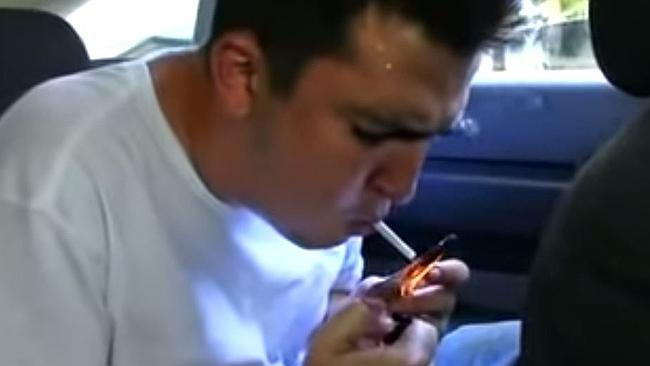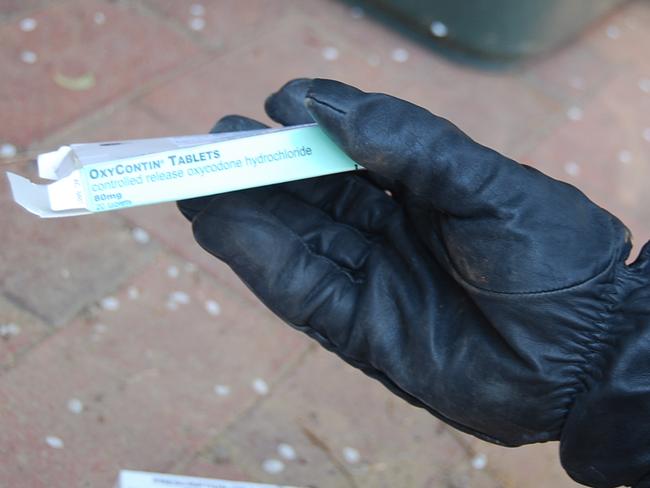Clever marketing and a faulty public perception is creating Australia’s silent drug epidemic
YOU might think ice is the scourge of Australia these days. But we’re killing ourselves in record numbers with prescribed drugs which are perfectly legal.

TODD Parkinson sits in the back of a car and holds a flame to an opiate-based prescription pain medicine and inhales the fumes. He is addicted to the mellow high, he tells the camera. It’s the same addiction that claimed his brother Drew and in years to come would claim him.
It’s a scene from the award-winning documentary Oxycontin Express which led to a major crackdown in the illegal trade of prescription drugs in Florida. It’s also a scene that Australian medical experts warn is now an alarming reality in our own backyard.
“We have now arrived at the same situation as America,” Clinical Director at Melbourne’s Eastern Health Dr Matthew Frei tells news.com.au
Oxycodone is prescribed by doctors to manage acute, chronic and cancer-related pain. The effects of the drug are similar to morphine and are so strong it’s earned the nickname “hillbilly heroin”.
Dr Frei is the president of the Addiction Chapter of the Royal Australasian College of Physicians. He believes laws and education around prescription drugs such as Oxycodone have not kept pace with the slick marketing of pharmaceutical companies.
“The pharmaceutical industry is encouraging doctors to prescribe their pills and that’s fine. But the teaching and awareness hasn’t kept pace with the marketing.”
The most recent data shows a 180 per cent increase in Oxycodone prescriptions from 2002 to 2009.
“Our horse has bolted,” Dr Frei said, referring to the prevalence of opiate-based prescription drugs in Australia.
“It’s no longer a question of whether it’s a problem. It’s well entrenched now ... We know that people are dying from this.”
He’s not the only one to make the disconcerting declaration. Last week, the Australian Medical Association (AMA) called prescription drug abuse a “national emergency”.

This week is the International Overdose Awareness Week and Aussie advocacy groups are trying to raise awareness of the perils of prescription drug abuse. With the national spotlight on the impact of methamphetamine on Australian communities, medical professionals are worried awareness around prescription drug misuse has been displaced from the public conscience.
“We need to bear in mind that in terms of number and burden, pharmaceuticals are right up there,” Dr Frei says. “I suspect it’s a much greater problem in magnitude.”
ScriptWise spokesman and AMA council of general practice in Western Australia Dr Steve Wilson told the ABC “it’s a bigger issue even than ice.”
Kim Ledger, the father of Australian actor Heath, is also a spokesman for ScriptWise following his son’s death from a prescription drug overdose in 2008.
He delivered a keynote speech at an event in Perth this week in which he highlighted the need to tackle the public perception of such drugs and a more comprehensive approach to controlling misuse. It’s a problem that he says is spiralling out of control.
According to organisation he represents, Oxycodone prescription in Australia increased more than 152 per cent between 2003 and 2008. A separate PubMed study conducted between 2002 and 2009 put the increase at 180 per cent.
Mr Ledger also singled out benzodiazepines as a major problem. The drug is a type of minor tranquilliser prescribed as a short-term remedy for people with sleeping or anxiety issues. “In Australia alone, there are around 10 million prescriptions written for benzodiazepines each year,” he said.
The effects for long term users of the drug include nausea, depression, cognitive impairment and possible brain damage.
@TrishWilliamsAu inspiring key note address by Kim Ledger. Patron of #scriptwise.
— Sandra Cook (@san879092) September 1, 2015
A PROBLEM OF PERCEPTION
Dr Frei views it as a cultural issue and one that is borne out of a fundamental misunderstanding.
“Just because it’s a commercial product doesn’t mean it’s inherently safe,” he says.
He believes Australian consumers have a growing expectation of a panacea in a pill meaning “more people are taking sleeping pills, anti-anxiety drugs and so on” without understanding the full dangers.
He says some doctors are “absolutely” trigger happy when it comes to prescribing such drugs to address mechanical discomforts. Dr Frei refers to mechanical problems as the typical “aches and pains of old age” which these drugs are increasingly being prescribed for, as opposed to cancer related pain. “We’re no longer happy just to grow old,” he says.
Countless actors including the Federal Health Minister Sussan Ley have called for greater measures to combat doctor shopping to ensure Australians aren’t abusing and dangerously mixing controlled drugs. While effective systems exist in states such as Tasmania and South Australia, a comprehensive federal response has been slow to come.
Dr Frei has spent more than 15 years working in the field of drugs and alcohol addiction and says; “when you dig deep into coroner reports (of those who have overdosed) quite often you see patients have been doctor shopping.”
It’s a statement that is reflected in the recent figures in Victoria which found prescription drugs were involved in 82 per cent of the 384 overdose deaths investigated by the Victorian coroner’s court in 2014.
It’s not just overuse and mixing with illicit and other prescription drugs that is leading to overdoses. With increased supply comes an increase in black market trade. According to a UNSW study on illicit drug trends between 2001 and 2013, more Australians are taking prescription drugs in non medical ways such as smoking or injecting them. The report indicated a 17 per cent rise in the practice of injecting oxycodone since 2005.
Just like Todd Parkinson in the back of that Florida car, the potential for abuse is ever present.
Something that the inaugural Australian Overdose Awareness Week, which runs through to September 6, wants to drag into the public consciousness.




